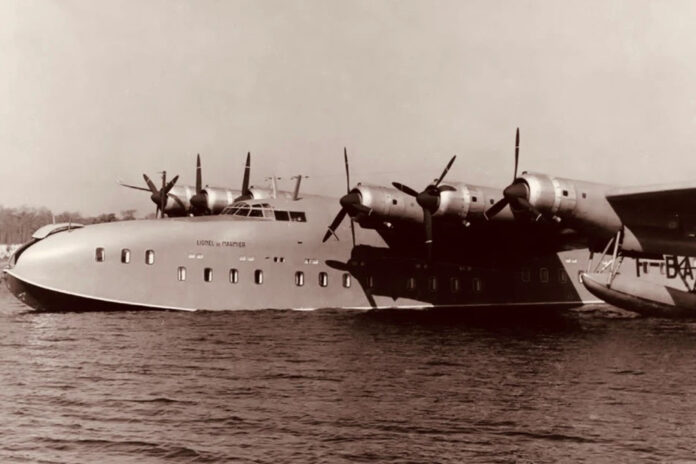At the end of the Second World War, French and British manufacturers manufactured gigantic seaplanes for intercontinental connections. Impressive devices, but very bad decisions.
In 1947, when it was put into service by Air France, the Latécoère 631 was the largest metal seaplane ever built. Long and thin, it is characterized by its endless nose and its V-shaped tailplane.
Powered by six propeller engines, it can travel 5000 km at a cruising speed of 290 km/h.
If you are a passenger departing from Biscarosse, south-west of Bordeaux, and bound for Fort-de-France, Martinique, you walk on the quay and enter the seaplane through a side door located at the rear . On your left, the kitchen. In front of you, reassuringly, two toilets. Turning right, you enter the central passageway, bordered on either side by compartments with two or four seats facing each other, closed by curtains. Most have their own sink. A total of 46 seats can be converted into overnight berths.
Above your head, on the upper deck, stretches a vast pilot cabin, extended by a rest cabin for the crew.
An Air France advertising brochure then said of the Latécoère 631 that “it is the first aircraft which, in its comfort, is truly akin to the ocean liner”.
Born in 1883, Pierre-Georges Latécoère had taken the helm of the small family manufacturing business in 1905 to transform it into a railway equipment factory. During the First World War, his factory began to manufacture military aircraft cells as a subcontractor, which awakened new ambitions in him.
In 1919, he founded the Latécoère Airlines to transport freight and mail between France and North Africa, using decommissioned military aircraft – the company would hire Antoine de Saint-Exupéry in 1926.
But Latécoère wanted to build his own aircraft and he created the Société Industrielle d’Aviation Latécoère (SIDAL) in Toulouse in 1922.
Following a call for tenders from the French government published in 1936 for a large civil seaplane with a long range of action, the chief engineer of Latécoère widened the project on which he was already working and designed a long and thin seaplane . It will be the Latécoère 631.
Air France placed an order for four aircraft and took possession of the first two in 1947, the 3rd and 4th models built.
When it entered service on the Martinique line in 1947, the Latécoère 631, with its 43 meters, was the longest existing passenger aircraft.
But the Brits dreamed even bigger and had given a delicate name to their own flying monster: Princess.
The Princess was huge. At 45 meters, the Saunders-Roe SR.45 was only a meter and a half longer than the Latécoère 631, but it weighed twice as much and was almost twice its height.
The 105 passengers it was to carry from London to New York were spread over two decks, as in the Airbus A380, which appeared half a century later.
Imagine two Airbus A330 fuselages nested on top of each other and add a shell underneath.
Ten turboprops in six nacelles, driving ten propellers, blended into the leading edge of its huge wings.
Two spiral staircases led from one deck to the other. The layout had to include a changing room for men, another for women, toilets, a dining room/bar. All 13 first class cabins had retractable berths. In tourist class, which was not yet called sardine class, the cabin was wide enough to accommodate six rows of comfortable seats.
The gigantic seaplane made its first flight in August 1952. But already, the British Overseas Airways Corporation (BOAC), which had ordered the first three copies, lost interest in the project. She instead set her sights on the De Havilland Comet, the first jet passenger plane in history, which itself would have a disastrous career.
No other airline is willing to join the dance and the princess is hanging out. The aircraft made its last flight in 1955, without having carried any passengers. Unlike the Latécoère 631. Unfortunately.
Air France has put three of the four Latécoère 631s ordered into service. From July 1947, the departures follow one another at intervals of 15 days. Then the tragedy occurs. On August 1, 1948, the Latécoère registered F-BDRC, the sixth in the series, lost body and belongings in the Atlantic, killing 52 people. He had accumulated 185 flight hours.
Air France withdrew its two other aircraft shortly thereafter. At Latécoère, the four aircraft under construction are transformed into cargo seaplanes. Three will crash with loss of life.
A total of 11 Latécoère 631s will be built. The last ones will be scrapped in the mid-1950s.
At Saunders-Roe, three Princess were assembled and only one flew. They were dismantled during the 1960s.
Latécoère and Saunders-Roe were clearly on the wrong track.
Already in 1945, Pan American Airlines had put the Lockheed Constellation into transatlantic service, the first civil aircraft with a pressurized cabin, which flies at 500 km/h. Long concrete runways were springing up everywhere on the planet. The Boeing 707, the first successful four-engine aircraft, entered service in 1958.
Saunders-Roe had an even bigger seaplane on the drawing board: the Queen, of course. Powered by 24 turbojets (six times more than the Boeing 747!), it was to accommodate 1,000 passengers on five decks. Unsurprisingly, the project never got off the ground.
The Saunders-Roe name will disappear over mergers and acquisitions in the British aviation industry.
Latécoère will no longer build planes under its own name, but will continue to build aeronautics as a subcontractor. The Latécoère Group currently employs nearly 6,000 people.
During the 1980s, the USSR had built a huge seaplane that flew at sea level, to take advantage of the extra lift provided by the proximity of the surface of the water. In May 2022, the United States Defense Advanced Research Projects Agency (DARPA) announced the launch of a hatchback seaplane project for heavy transport, also intended to fly at sea level, the Liberty Lifter.
Large seaplanes may not have said their last word.

